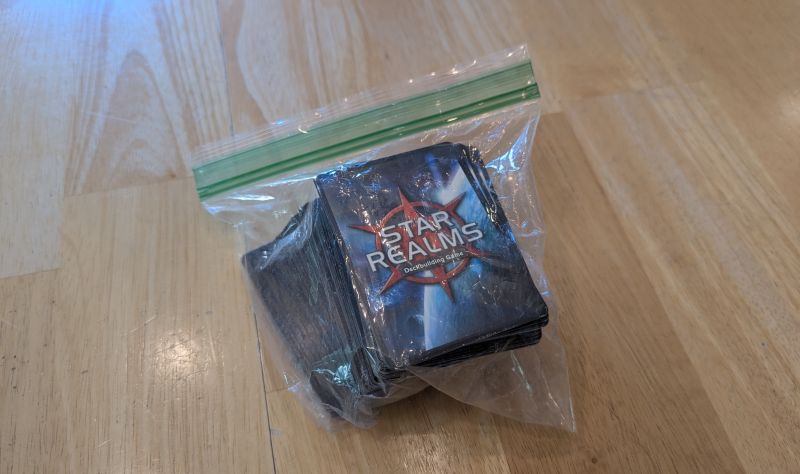
Today’s game is an oldie but a goodie in this household: Star Realms by Wise Wizards LLC (unfortunately, there are no space wizards in this game), a fast-playing deck builder that is easy to learn, difficult to master, and subject to enough randomness to help level the playing field. I played this about a week ago with my youngest son while we sat on the ferry.
Premise
The premise of this game is that each player is the commander of an armada and is attempting to wrest control of local space by destroying the “authority” (read: health) of the other players. Your armada (read: deck) starts small with a standard set of ten ships, but with each turn you can strategically add ships from four different factions to your armada using trade (read: money) and attempt to reduce your opponent’s authority with combat (read: damage). The last player standing is the victor!
Components
Quality: 3/5 (standard cards, nothing fancy)
Quantity: 1/5 (just a deck of cards)
Organization: 2/5 (it’s complicated)
The base game comes with 118 cards total: 80 trade deck cards, 16 scout cards, 10 explorer cards, 4 vipers, and 18 authority cards. I have an expansion in there that bumps up that trade deck, but I can’t remember which one it is. Otherwise, that’s it!
The trade decks cards are comprised of ships and bases. Ships are ephemeral and are immediately discarded after being played, but bases remain until you scrap them or your opponent destroys them, usually giving you a small bonus to trade, authority, or combat each turn they continue to exist. The explorer cards are basic ships that are available until they have all been bought and serve as a good backup choice if you can’t afford or don’t want any of the ships available to buy. The scout and viper ships are basic ships that will comprise your starting hand, and the authority cards are used to track how much authority you have remaining. There are two types of authority cards and they are reversible: 1/5 cards and 10/20 cards.
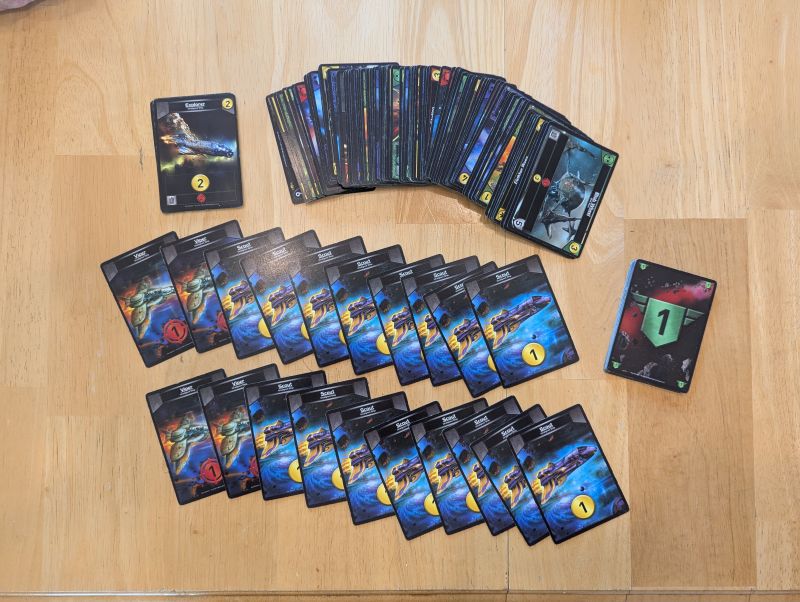
There isn’t really any organization to speak of; the cards come in a tuck box that only fits the base game (thus my custom ziploc bag). My approach is to use the two instruction sheets as dividers, separating the trade cards into one section, the authority cards into another, and the scouts, vipers, and explorers into the third and final section. This keeps the game easy to setup and put away, in my opinion. But there are plenty of card organization solutions out there, so you can organize as much or as little as you like.
Setup
Complexity: 1/5 (very fast)
Footprint: 2/5 (new metric! not too much space)
Setting up Star Realms is extremely fast…unless you mixed all your cards together. Using my previously described system, all you have to do is shuffle the trade card pile and place it face-down between the two players, slightly to one side. Draw the top five cards and place them face-up in a row next to the pile; this is the “store”. Place the pile of explorer cards on the other side of the trade card pile. Finally, give each player a shuffled pile of 8 scouts and 2 vipers, placed face-down in front of them (this is their armada), as well as 3 10/20 authority cards and 6 1/5 authority cards (I’ll dive into those in the rules section). Whoever will go first draws three cards and all other players draw five cards from the top of their armada decks as their starting hands. And there you have it, you’re ready to play!
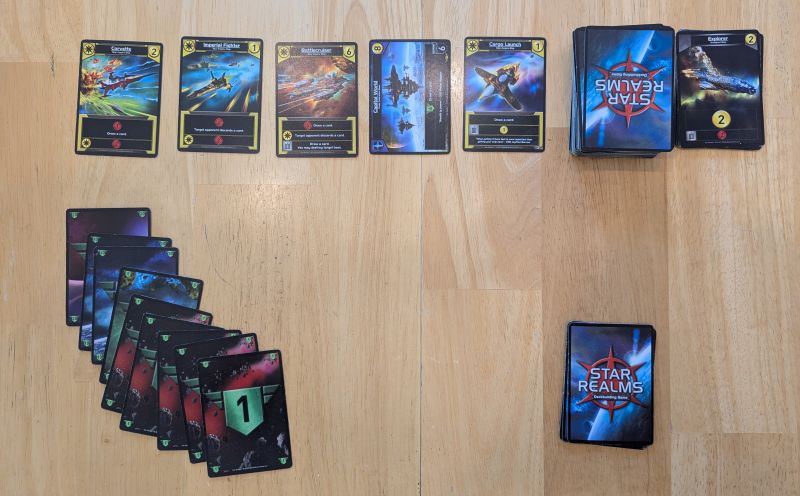
Rules
Players: 2-4 (2 is my preference)
Time: 20-30 minutes (fairly quick, depends on the game)
The rules are not super complex, but there is a small learning curve. Players take alternating turns which are split into three parts. The first part is where all the action happens. The player plays all ships in their hand (unless they are scrapped by some ability), uses the primary abilities of any bases in play, uses any ally abilities (triggered when you have at least two cards of a faction in play), uses trade generated by their cards to purchase new ships from the discard pile, and apply combat generated by their cards to their opponents authority and/or bases. Once that is done, the player discards all ships and newly purchased cards into their discard pile. Finally, the player draws five new cards from their armada deck and the next player starts their turn.
Beyond these simple rules, there are a lot of considerations. Some ships and bases have a scrap ability (noted by a little trash can), where you gain a one-time bonus from removing them from the game. There is also a lot of variation in abilities beyond adding combat, authority, or trade. Some allow you to outright destroy a base, or act as an ally to any faction, or even to copy the attributes of another ship you’ve played that same turn! Additionally, some bases have the outpost tag on their defense score (the little shield in the lower right corner). If a base is an outpost, it must be destroyed first before any combat can be applied to the owning player, and it has to be destroyed in one round (no health tracking here). If it isn’t an outpost, a player can choose to target it or the owning player instead.
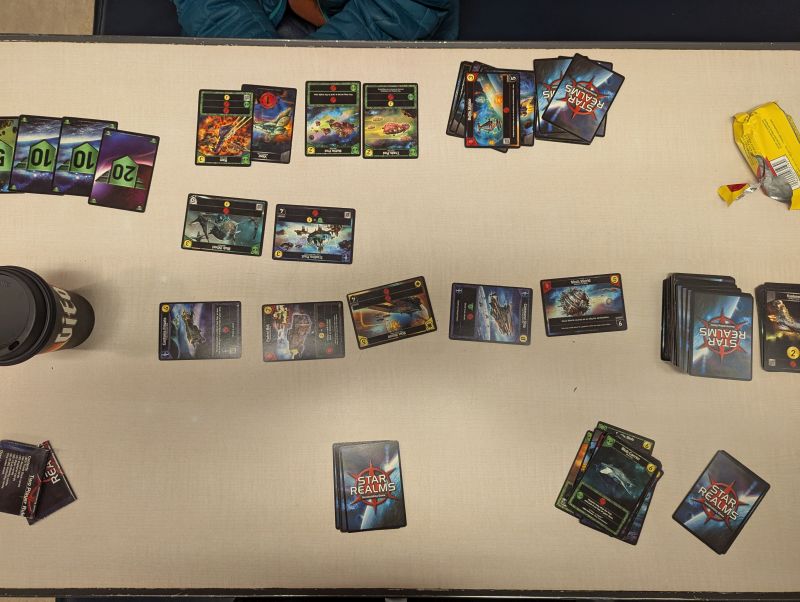
Finally, I just want to discuss the factions a little. There are four: the Blob, the Trade Federation, the Star Empire, and the Machine Cult. The Blob is a brute force faction, dealing large amounts of combat, but also has a decent number of abilities allowing you to draw additional cards (and pile on more combat). The Trade Federation is the opposite, dealing low amounts of combat but providing a lot of trade and authority (read: healing), as well as many outpost bases. The Star Empire has a decent amount of combat but really excels at abilities that either let you draw more cards or force another player to discard cards from their hand. Finally, the Machine Cult deals decent damage but also allows you to often scrap cards from your hand or discard pile. While this may seem counterintuitive at first, it allows you cull your weaker cards (like scouts and vipers) quickly, making your deck concentrated with more powerful cards which will be played more often.
What I Liked
I really enjoy this game. It’s easy to learn, hard to master, and even if you master it, the luck of the draw with the trade row and your own hand can flush that all down the toilet. I also enjoy that you get a small sense of the world behind it with flavor text, but just a hint; there isn’t really any central story to this game.
Another nice element is that the game has many, many expansions that, while unnecessary, add some spice if you get bored with the base game. I myself only own one and honestly, my trade deck is already huge enough.
What Could Be Better
I feel bad, but I have no complaints. It’s a real “if it isn’t broke, don’t fix it” situation.
Results
No shame, my younger son mercilessly crushed me 45-0. I had decided to pursue Trade Federation ships with some Blob ships for combat; this is a slow burn strategy that, if you get set up, allows you to continually heal until you wear your opponent down. My son’s strategy was to go 100% blob, get every card he wanted in the trade row, and then go for my jugular. Strangely, neither of us purchased any explorers, which is a good option in the first few turns to build up an economic base. Anyway, this was his revenge for Pokemon Labyrinth and I look forward to paying it back.
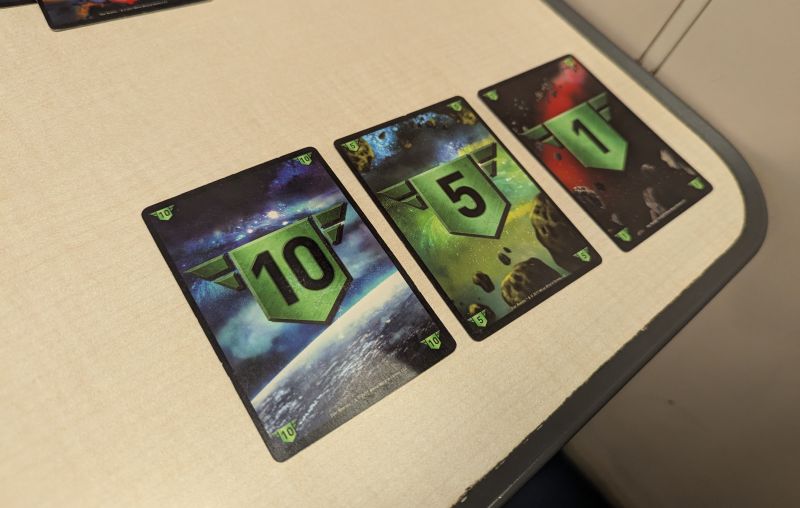
Recommendation
Age: 9+, Fun: 5/5
Replayability: 5/5
This game is a quick and excellent deck builder to play with another person. I highly recommend everyone get a copy and then tell me what your strategies are. I obviously need the help!